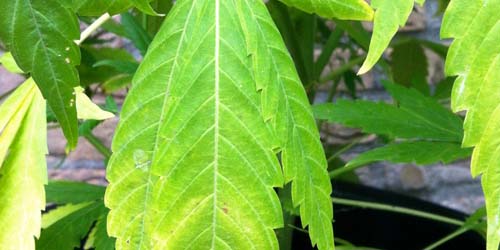
Deep yellow leaves, brown spot and patches... According to part 2 in the leaf problem series your weed plant has a deficit in a particular substance. It’s great that you can recognise what your precious plant needs but what can you actually do about it? In this instalment of Leaf Problems it’s time to think about practical solutions. What fertilizer (and how much) should you use to make your plant healthy again?
In this series:
- The Basis of a healthy weedplant
- Recognising deficits in the weed plant
- Life-threatening diseases of your weed plant
- This article
Weed Leaf Problems – Brief Summary
This article presupposes that you use the other articles in this series on leaf problems as a reference work. We don’t want to repeat ourselves too much and would prefer to get straight on to the juicy details. It goes without saying that we aren’t going to leave you and your plant to fate! Hence the brief description of your weed leaf problems in the following summary. But please note: all the information in this article is based on the assumption that you are cultivating in soil. Potting compost and garden soil themselves contain some nutrients that provide for your plant up to a certain point. That is not the case for untreated coconut fibre, stone wool and hydro/aero systems. We showed these pictures in part 2 of this series.
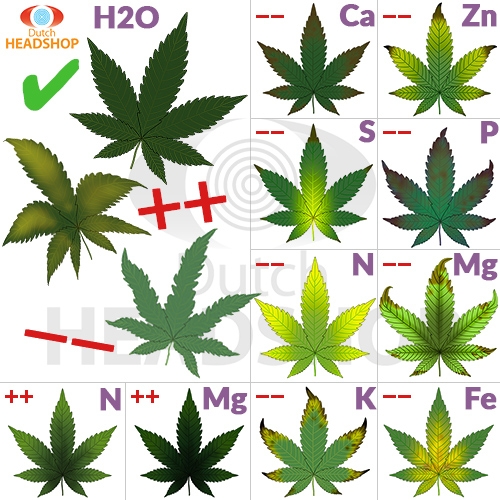
Deficits and surpluses in a handy schematic.
Legend for the above picture:
- ? - This is what a weed leaf should look like. Nice and even in colour, without any distortion. Please note that there can be slight differences in the colour of the leaf. A purple, light-green or deep-green leaf can be just as healthy. More on this, later.
- -- - Two minuses means too little.
- ++ - Two pluses, on the other hand, means too much (overdose).
- H2O - Water, Ca - Calcium, Zn - Zinc, S - Sulphur, P - Phosphorus, N - Nitrogen, Mg - Magnesium, K - Potassium, Fe - Iron.
The most important skill that you can teach yourself is being able to distinguish whether your plant is getting an abnormal amount of water or has a nutritional problem. If you can recognise that difference and the light, drainage and ambient temperature are all at the correct levels, then it’s fairly simple to identify what’s wrong with your weed plant.
Nine times out of ten, an uneven colouration is a problem with the fertilizer
Symptoms of potassium deficit
If you give too little water, the leaves feel brittle and paper-like. In that case, they no longer feel springy but stiff. They gradually wilt and fade in colour. Not giving enough water can resemble a potassium deficit.
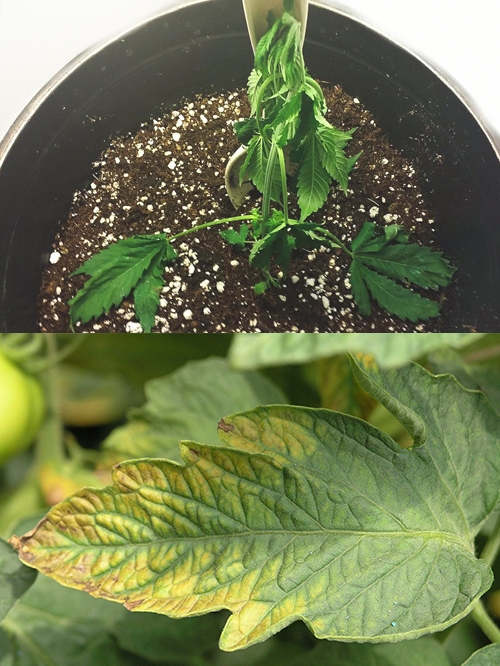
Above: too little water. Below: potassium deficit.| Photograph below: Goldlocki via Wikipedia / CC BY-SA 3.0
It doesn’t matter that the leaf pictured here comes from a different plant. The colouration and identification are as good as universal. A potassium deficit usually results in the light-green colour and the brown spots in combination with yellowing ends.
Symptoms of nitrogen deficit
If you give your weed too much water, the leaves will feel heavy and start to sag. The leaves are literally saturated with water. In extreme cases, you see very yellow leaves. This colouration can be confused with a nitrogen deficit in which the tips and the leaf in between the ribs turn yellow.
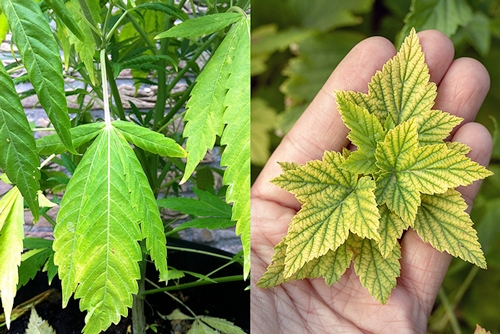
Left: too much water. Right: nitrogen deficit.
A frequently occurring nitrogen deficit can be recognised by the difference between the leaf rib (green) and the leaf itself (yellow). Otherwise, the leaf looks fine at an early stage. On the other hand, if you give too much water, the form of the leaf appears different from what it should be.
How Much Water do you Give a Weed Plant?
Water your weed plant when the upper layer of the soil feels dry. Poke your finger in the soil. If the top 2 to 3 centimetres feel damp but not drenched then that is exactly right! Then just give a bit of water. Preferably with a bit of fertilizer. But what fertilizer?
Solving Leaf Problems – Easier than you think!
Are the ladies looking a bit under the weather? In 9 out of 10 cases, this is down to your weed plant getting too little fertilizer. No wonder they become lifeless! The first question you have to ask yourself is at what stage is your plant. Then you can decide whether the problem is to do with watering, or whether there is a deficit in the fertilizer. Let’s get started. You’ll see that the whole story regarding fertilizer is actually quite simple.
Seeds and seedlings
Sufficient nutrition is contained in weed seeds to allow your plant to germinate and develop the first pair of leaves. You can, however, speed up this process using what are referred to as seedboosters. For example, choose:
- Plagron Seedbooster Plus - Speed up the germination process of your weed seeds.
- BAC X-Seed - The organic plant strengthener for increased germination percentage.
Seedlings are germinated weed seeds with several round leaves. Don’t give seedlings any fertilizer. They are not yet ready to handle it. Only feed weed plants when there are a minimum of 2 large, serrated leaves on the stem (and preferably 4).
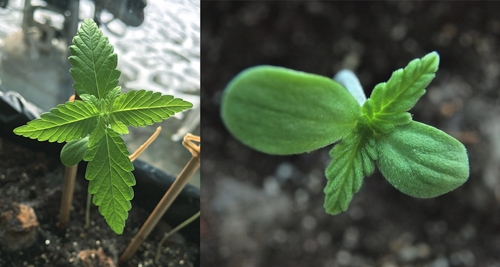
Left: mature enough for fertilizer. Right: too immature for fertilizer.
Growing Phase of Weed Plant (vegetative phase)
Are there enough leaves on the weed plant? In that case, it’s in the growing phase. If you see for the first time the characteristically hand-shaped leaf, with some 3 to 9 fingers, then you know it’s got there. During the growing phase, your plant is desperately in need of primary nutrients. So give your plant the following fertilizer (even if you are not seeing any deficit). In this way, you’ll prevent leaf problems and strengthen the plant.
- Feed for growing like Plagron Terra Grow contains a sophisticated blend of nitrogen fixers, phosphorus, potassium and trace elements to make your plants big and strong. Do you think that your weed plant has a deficit in one of these substances? If so, you know what to do!
- For organic cultivation you can choose, for example, between Plagron Alga Grow, Royal Queen Easy Boost and BAC Bio Groeivoeding. Just as good for your plant but organic in origin. All Plagron Alga products and fertilizer from BAC are also vegan, which means that they are not made from animal biomass but from algae and/or other plant remains. You can cultivate weed organically with these products.
Feed for growing is good for your plant. It can help you in the case of certain leaf problems and solve nutritional deficiencies. But please note: don’t give too much. Keep to the dosage stated on the bottle. This will prevent you from getting problems.
Flowering Phase for Weed
Feed for flowering like Plagron Terra Bloom contains less nitrogen and a bit more phosphorus, magnesium and iron (so in the case of a deficit of these substances, give this fertilizer). That comes about because the nutritional requirement of the plant changes during flowering. Think of a plant in flower as a bit like a pregnant woman needing additional folic acid.
After a few weeks in the sun or under the lamp, most autoflowers are already starting to produce pistils. This is the point at which you can tell whether your plant is male or female. Read here about how you recognise that. See any males? Get rid of them immediately! Certainly if you have more than one plant. Traditional weed plants (photoperiod plants or ‘non-autoflowers’) will flower if the light changes. You can read how exactly that works here.
Is your plant suffering from deficits in the flowering phase, e.g. with brown marks on the leaf or yellow ends? If so you need to go to work fast and decisively. Order the following fertilizer and give it with each watering according to the instructions on the bottle or in the detailed product description. Choose from one of the following organic fertilizerss for weed plant flowers: Plagron Alga Bloom or BAC Bio Bloeivoeding. These fertilizerss will help your plant to recover from the deficits.
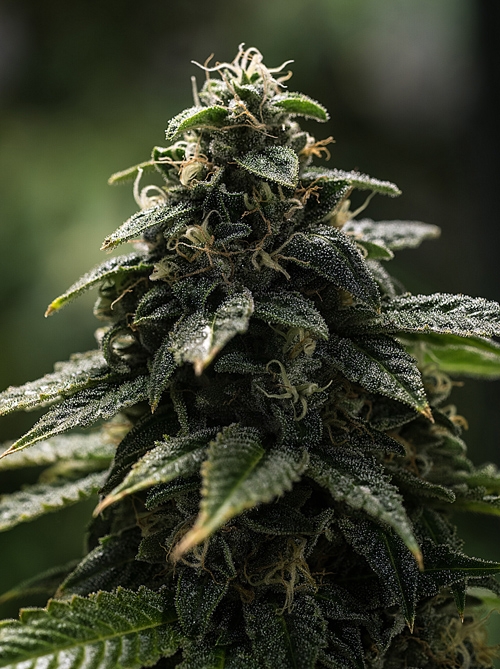
Flowering cannabis
Rinsing Weed
Before you harvest, it’s a good idea not to give any more (flower) fertilizer during watering. This ensures that the weed doesn’t develop an after-taste. We call this rinsing. By rinsing, you bring all the nutrients out of the soil. It forces the plant to use up all the the nutrients present and this enhances the taste of your weed and increases the amount of yield. Don’t give any more fertilizer in the final 2 weeks before the harvest.
Of course this is like looking in a crystal ball, because how do you know you’ll be harvesting in 2 weeks? This is why it’s important to know how long, on paper, your plant takes to flower (indicated in the product information for the seed). If the flowering period is 7 weeks, then you stop feeding in the fifth week of flowering. It’s that simple. Do you want to know precisely down to the day when you should harvest? In that case, keep a good eye on your plant by monitoring the trichomes.
Examine the plant’s trichomes under a magnifying glass or with a trichoscope specially designed for that purpose. As soon as these resin glands begin to change colour from transparent to milky white, it’s time to get into action. Read our blog How and When to Harvest Weed for a detailed description. After reading this blog, you should certainly manage to choose the perfect moment!
Special Cannabis Fertilizer
So far we’ve looked at the essential fertilizers. The fertilizers discussed above ensures that you won’t have any leaf problems as a result of nutritional deficits. You can also resolve deficits with these fertilizerss. But there are also special types of fertilizer. Where (and for what deficits) do you use these for then? In short:
- Plagron PK 13-14 - Gives your plant additional phosphorus (P) and potassium (K) only. For more compact and bigger buds. Give from the fourth week of flowering up to no later than 1 week before the harvest.
- Plagron pH min - Reduces the acidity of your soil or water which facilitates the uptake of fertilizer. Ideal if your weed is in chalky soil or if your tap water contains a lot of minerals (which is often the case!). You often use pH min to adjust the acidity of your feeding water.
- BAC Bio Clone Stekpoeder Gel - Specially for strengthening each cutting and prevention of fungal infections.
- Plagron Sugar Royal & Plagron Green Sensation - These are flower stimulators. A dessert for your weed plant to give it extra taste and aroma! Give in combination with normal weed fertilizer from the third week of growth up to no later than 1 week before the harvest.
- Plagron Power Roots - Roots are the foundation of your weed plant which manage the uptake of water and nutrients. Strong roots mean: a big plant and a nice big yield! Give from the first week of growth up to no later than the first 3 weeks of flowering, in combination with normal weed fertilizer. Helps to prevent or recover from root rot.
Special Colours - Rainbow Weed
Not every colouration is necessarily the result of a surplus or deficit of a nutrient. If you’ve gone through the following list and are able to put a big tick everywhere then your weed plant doesn’t have any deficits.
- ✔️Soil sufficiently aerated / surplus water can drain
- ✔️Weed plant is in a sunny place in the garden or greenhouse, or has sufficient artificial light
- ✔️Enough water, but definitely not too much
- ✔️No spider mites, thrips, mildew or other diseases or infestations
- ✔️Sufficient fresh air
- ✔️;Temperature between 20 and 25 degrees Celsius
- ✔️pH between 5.8 and 6.3
- ✔️Humidity during growth: maximum. During flowering, between 40 and 60%
- ✔️The right fertilizer throughout the life cycle of your plant
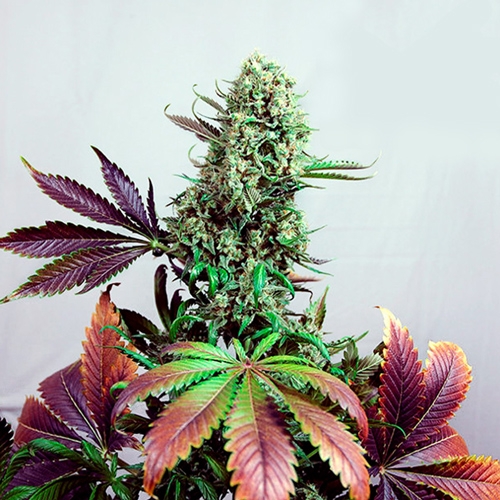
Weed with red, blue or purple leaves and/or buds during flowering? That could very well be normal for your variety.
Purple Haze and Blueberry varieties are renowned for richly coloured leaves during the flowering phase. Purple weed is cultivated by lowering the temperature of suitable varieties like these during flowering. Just under 10 degrees is perfect but don’t make the difference between day and night too great.